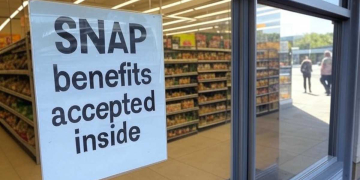Have you already heard about the extra money that Sacramento is giving out? Yes, as you hear it: $725 a month fall into the bank accounts of families that qualify. But before you jump up and down with excitement, grab your coffee (or your energy drink) and I’ll tell you all the important gossip about this show.
Turns out the city launched a cool social experiment called the Family Economic Support Pilot Program (FFESP). Basically, for an entire year – from December 2024 to November 2025 – certain Sacramento families will receive $725 a month without having to sell their souls. The idea is to help with basic expenses: food, rent, diapers, daycare… you know, that thing that always goes through our hands like water.
Who qualifies for the FFESP stimulus program?
Here comes the important thing: it is not for everyone. The program has its rules, but they are not that complicated. Let’s go in parts:
- You live in certain zip codes: Check if your neighborhood is on the list: 95815, 95821, 95823, 95825, 95828 or 95838. If not, don’t even move it (but be careful, there may be other similar programs).
- You have a child under 5 years old: This is key. If your child already turned five before December 2024, it does not apply. Those who have babies at home take advantage!
- You earn less than 200% of the federal poverty level: To give you an idea, if you are a family of four, your annual income must be less than approximately $60,000. If you live alone with one child, the cap is like $40,000.
If you want to claim the cash, put your papers in order: You need to prove income (W-2, pay stubs, tax returns) and residency (an electric bill or rental agreement will do). Nothing out of this world, but you do have to move.
When will payments for these stimulus checks be sent?
Good question. Deposits are direct to your bank account each month, starting in December of this year. That is, if you applied on time, in December you will see the first deposit. But be careful: the last payment will be in November 2025, so there are 12 months of financial respite. Oh, and if you’re wondering why they’re doing this… well, the city wants to test whether giving ongoing aid (instead of a single check) reduces economic stress in communities that have historically suffered the most, especially African American and Native families.
It’s not just throwing money from a helicopter (even though it sounds fun). The plan has three secret objectives:
Empower without paternalism: Let families use money as best suits them. Paying debts? Inviting the kids to Disneyland? That’s up to you, but your judgment is trusted.
Level the game: According to county data, those ZIP codes have more child poverty and less access to services. Silver seeks to close that gap.
Generate useful data: Being a “pilot”, they want to see if this model could be replicated in other cities. In other words, you could be part of a change at the national level!
Should the money be returned?
Look, everything indicates that it is legitimate. The money comes from state and federal funds allocated to anti-poverty programs. Yes indeed:
- It is not a loan: You do not have to pay it back.
- Does not affect other benefits: If you receive SNAP, Medicaid or housing assistance, this does not take them away from you.
- Beware of scams: The city will not call you to ask for banking information over the phone. If someone demands money from you to “speed up your application,” report them!
So, prepare your digitized documents: identification, proof of address, child’s papers (birth certificate, social security). If you don’t have a bank account, open one now. Some credit unions offer free accounts with no fees.
First, review the requirements carefully. Are you sure your zip code is not on the list? Does your child turn 5 years old after December? If you definitely don’t, don’t worry: there are other supports like CalFresh, child care scholarships, or energy assistance programs. Check the county social services page.




